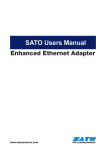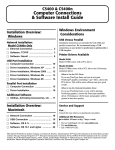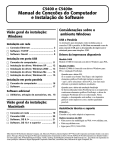Download Oki LAN 510W User's Manual
Transcript
Every effort has been made to ensure that the information in this document is complete, accurate, and up-to-date. The manufacturer assumes no responsibility for the results of errors beyond its control. The manufacturer also cannot guarantee that changes in software and equipment made by other manufacturers and referred to in this manual will not affect the applicability of the information in it. Mention of software products manufactured by other companies does not necessarily constitute endorsement by the manufacturer. While all reasonable efforts have been made to make this document as accurate and helpful as possible, we make no warranty of any kind, expressed or implied, as to the accuracy or completeness of the information contained herein. For the latest information, go to http://my.okidata.com. Copyright © 2005 by Oki Data Americas, Inc. All rights reserved. As an ENERGY STAR® Program Participant, the manufacturer has determined that this product meets the ENERGY STAR guidelines for energy efficiency. Oki Data and OkiLAN are registered trademarks of Oki Electric Industry Company Ltd. ENERGY STAR is a registered trademark of the United States Environmental Protection Agency. Ethernet is a registered trademark of Xerox Corp. Microsoft and Windows are either registered trademarks or trademarks of Microsoft Corporation in the United States and/or other countries. Netscape is a registered trademark of of Netscape Communications Corporation in the United States and other countries. Other product names and brand names are registered trademarks or trademarks of their proprietors. OkiLAN 510w Configuration Guide, P/N 59368001 Rev 1.0 2 CONTENTS Basic Information . . . . . . . . . . . . . . . . . . . . . . . . . . . . . 4 Self-Diagnostic Test . . . . . . . . . . . . . . . . . . . . . . . . . . . . . . . . . . . . . 4 Specifications . . . . . . . . . . . . . . . . . . . . . . . . . . . . . . . . . . . . . . . . . 5 Resetting to Factory Defaults . . . . . . . . . . . . . . . . . . . . . . . . . . . . . . 5 Configuration Overview . . . . . . . . . . . . . . . . . . . . . . . . 6 Network Modes . . . . . . . . . . SSID (Service Set Identifier) . Channels . . . . . . . . . . . . . . Security Features. . . . . . . . . . . . . . . . . . . . . . . . . . . . . . . . . . . . . . . . . . . . . . . . . . . . . . . . . . . . . . . . . . . . . . . . . . . . . . . . . . . . . . . . . . . . . . . . . . . . . . . . . . . . . . . . . . . . . . . . . . . . . .6 .7 .7 .8 Summary of Configuration Modes . . . . . . . . . . . . . . . . 10 Ad Hoc Mode . . . . . . Infrastructure Mode . Telnet Mode . . . . . . Control Panel Mode . . . . . . . . . . . . . . . . . . . . . . . . . . . . . . . . . . . . . . . . . . . . . . . . . . . . . . . . . . . . . . . . . . . . . . . . . . . . . . . . . . . . . . . . . . . . . . . . . . . . . . . . . . . . . . . . . . . . . . . . . . . . . . . . . . . . . . . . . . . . . 10 10 10 10 Configuration: Ad Hoc Mode . . . . . . . . . . . . . . . . . . . . 12 IP Address . . . . . . . . . . . . . . . . . . . . . . . . . . . . . . . . . . . . . . . . . . 12 Configuration . . . . . . . . . . . . . . . . . . . . . . . . . . . . . . . . . . . . . . . . 13 Configuration: Infrastructure Mode . . . . . . . . . . . . . . 18 IP Address . . . . . . . . . . . . . . . . . . . . . . . . . . . . . . . . . . . . . . . . . . 18 Configuration . . . . . . . . . . . . . . . . . . . . . . . . . . . . . . . . . . . . . . . . 19 Configuration: Telnet . . . . . . . . . . . . . . . . . . . . . . . . . 38 Configuration: Printer Control Panel . . . . . . . . . . . . . . 41 Troubleshooting . . . . . . . . . . . . . . . . . . . . . . . . . . . . . 42 3 BASIC INFORMATION SELF-DIAGNOSTIC TEST _______________ To print the self-diagnostic test for the wireless network card: 1. Make sure Ready to Print appears on the display. 2. Press the TEST button (1) on the wireless network card for at least 3 seconds. The Network Summary report prints. 4 Basic Information SPECIFICATIONS_____________________ IEEE • 802.11b • 802.11g SECURITY: Authentication WEP Shared Key WPA-Home WPA-PSK Encryption WEP 64 or 128 bits TKIP WPA-Enterprise EAP-TLS TKIP PROTOCOL TCP/IP COEXISTENCE WITH WIRED PRINT SERVER • Both can work simultaneously as independent interfaces • Each has separate configuration (including IP Address) and separate certificates. • Packet routing is not performed between the two. RESETTING TO FACTORY DEFAULTS ________ To reset the wireless card to the factory default settings: 1. Turn off the printer. 2. Press and hold the TEST button on the wireless card while turning the printer back on. Keep pressing the button until Wait a Moment Network Initializing appears on the display. 3. Wait for Ready to Print to appear. 5 Basic Information CONFIGURATION OVERVIEW NETWORK MODES ___________________ Ad-Hoc Infrastructure 6 Configuration Overview SSID (SERVICE SET IDENTIFIER) _________ In a wireless network, terminals can be assigned an SSID identifier which restricts their access to printers on the network to only those set up for that SSID. For example, computers set up as Accounting can only communicate to a printer through the Marketing access point (AP) and computers set up as Marketing can only communicate to a printer through the Marketing access point: SSID = Accounting SSID = Marketing SSID = Accounting SSID = Marketing CHANNELS_________________________ There are 13 channels available for use in a wireless network. However, adjacent channels share a frequency and can interfere with one another. Therefore, to obtain maximum communication speed and accuracy, channels for access points which are near each other should be selected with 5 channels space between them: e.g., channels 1, 6 and 11. 7 Configuration Overview SECURITY FEATURES __________________ Open (no security) This can be used, but is not recommended. WEP Wired Equivalent Privacy, assuring wireless network security equivalent to a wired network. Set the same WEP key (64 or 128 bits) for all printers, computers and access points on the wireless network. WPA WiFi Protected Access security, using TKIP encryption. This security uses a pre-shared key set for all printers, computers and access points in the wireless network. The key is periodically changed. EAP (Using Certificates) Extensible Authentication Protocol security. In wireless communications using EAP, connection to the wireless network is requested through an access point, which in turn transmits the certificate assigned to the computer and printer to an authentication server such as RADIUS. • EAP-TLS is used for authentication. • Client and/or CA certificates must be imported into the printer. • Certificates must be obtained separately by the network administrator before setting the printer for EAP. Client Certificates • This is the printer’s own certificate. • The client must have a private key which corresponds to a public key contained in the certificate. • Required file format for imported certificates = [PKCS#12]. • Suitable file extensions include *.p12 and *.pfx. CA Certificates • The printer is not involved in the CA certificate chain. 8 Configuration Overview • EAP-TLS requires authentication of the Server Certificate issued by a Certificate Authority and sent from a RADIUS server. • Certificate Authentication requires that the printer have a certificate issued by the Certificate Authority that issued the Server Certificate. • Required file formats = [PEM] or [DER]. • Suitable CA Certificate extensions include *.pem, *.der and *.cer. 9 Configuration Overview SUMMARY OF CONFIGURATION MODES AD HOC MODE _____________________ In this mode, wireless computers communicate with the printer peer-to-peer, gaining access through an SSID you set. Available security features for Ad Hoc Mode: • Open (no security) • WEP Shared Key Security INFRASTRUCTURE MODE _______________ In Infrastructure Mode both wireless and wired computers communicate to the printer through an access point such as a hub. Available security features for this mode include • • • • Open (no security) WEP Shared Key Security WPA Pre-Shared Key Security EAP Certification Security TELNET MODE ______________________ This mode sets up the printer using Telnet commands. Available security features for this mode include • • • • Open (No Security) WEP Shared Key Security WPA Pre-Shared Key Security EAP Certification Security CONTROL PANEL MODE _______________ You can also configure the wireless card through the printer’s control panel, but this mode is very limited. 10 Summary of Configuration Modes You can set up an SSID of your choice for accessing the printer over a wireless network, but no other security can be configured through the control panel. 11 Summary of Configuration Modes CONFIGURATION: AD HOC MODE NOTE These instructions assume the following: • You have connected the printer’s built-in print server. • You have configured both the printer’s and computer’s IP Address, Subnet Mask and Default Gateway. IP ADDRESS _______________________ For the Wireless Card The IP Address for the wireless card is set automatically. It appears on the wireless card Network Summary printout (see page 4) under TCP/IP Configuration. To set the IP Address manually, use the printer menu: 1. With Ready to Print on the display, press ENTER to switch to the Menu Mode. 2. Use the ∇ and ∆ buttons to scroll to [Admin Setup]. Press ENTER. 3. Use the ∇, ∆ and ENTER buttons to enter your 4-digit password (default is 0000). Press ENTER. 4. Use the ∇, ∆ and ENTER buttons to scroll to [Network Setup] → [Slot2:Wireless] → [IP Address Set], then select [Manual]. Press ENTER. 5. Use the ∇, ∆ and ENTER buttons to enter the IP Address. Press ENTER. 6. Press BACK. 7. Use the ∇ and ∆ buttons to scroll to [Subnet Mask], then use the ∇ and ∆ buttons to set the Subnet Mask values. Press ENTER. 12 Configuration: Ad Hoc Mode 8. Press BACK. 9. Use the ∇ and ∆ buttons to scroll to [Gateway Address], then use the ∇ and ∆ buttons to set the Gateway Address. Press ENTER. 10. Press ON-LINE to exit the Menu mode. For the Wireless Computer Set the IP Address using Microsoft Windows® Control Panel. CONFIGURATION ____________________ Configuration Using Web Browser 1. Open the browser. 2. Enter the IP Address for the printer’s built-in print server and press the Enter key. 3. Click [Change Slot]. 13 Configuration: Ad Hoc Mode 4. Select PCI Slot2:Wireless, then click [OK]. 5. Click Administrator Login. 6. Enter User ID = root Password = last six digits of the Mac (Ethernet) Address for the wireless card (under General Information on the Network Summary printout–see page 4), minus the punctuation marks. 7. Click [Skip]. 8. Select the [Network] tab. 14 Configuration: Ad Hoc Mode 9. Click [Wireless LAN] on the left side of the screen. 10. Make your selections: • Network Type = Ad Hoc • Communication Mode = AUTO or 802.11b • Channel = 1 through 13 (to ensure speed and accuracy when using wireless access points which are near each other, be sure to leave 5 blank channels between assigned channels; e.g., select channels 1 / 6 / 11) • SSID = (name you select) • Authentication = Open or Shared Key (WEP) 11. Click [Submit]. 15 Configuration: Ad Hoc Mode Configuration Using AdminManager NOTE If you are using AdminManager to configure the wireless card, and you have not installed the utility on your computer, you will need the CD supplied with your printer to launch the utility. 1. Launch AdminManager: • From your computer: [Start] → [Programs] → [OKI Setup Utility] → [Admin Manager] • From CD, after AutoRun: [(Language]) → [Next] → [Custom Install] → [Network Software] → [Installation/Config] → [Admin Mgr / Quick Setup] → [(language)] → [OKI Device Standard Setup] → [Execute from CD-ROM] → [Next]. 2. Wait for the software to discover the printer (if automatic discovery fails, click [File] → [Search]). The printer appears as MLETB13 or OkiLAN8200e. 3. Click the discovered printer, then select [Oki Device Setup] from the Setup menu. 4. Select [Guest User], click [OK]. 16 Configuration: Ad Hoc Mode 5. On the [General] tab, click [Change SLOT], then click [Yes]. 6. Referring to the Network Summary printout for the wireless card (under General Information), enter the last six digits of the Mac address as the password (minus any punctuation), then click [OK]. 7. Scroll over to the far right and click the [Wireless] tab. 8. Make your selections: • Network Type = Ad Hoc • Communication Mode = AUTO or 802.11b • SSID = (name you select) • Authentication = Open or Shared Key (WEP) • Channel = 1 through 13 (to ensure speed and accuracy when using wireless access points which are near each other, be sure to leave 5 blank channels between assigned channels; e.g., select channels 1 / 6 / 11) • SSID = (name you select) 9. Click [Initialize]. 17 Configuration: Ad Hoc Mode CONFIGURATION: INFRASTRUCTURE MODE NOTE These instructions assume the following: • You have connected the printer’s built-in print server to a computer via an access point. • You have configured both the printer’s and computer’s IP Address, Subnet Mask and Default Gateway. IP ADDRESS _______________________ For the Wireless Card The IP Address for the wireless card is set automatically. It appears on the wireless card Network Summary printout (see page 4) under TCP/IP Configuration. To set the IP Address manually, use the printer menu: 1. With Ready to Print on the display, press ENTER to switch to the Menu Mode. 2. Use the ∇ and ∆ buttons to scroll to [Admin Setup]. Press ENTER. 3. Use the ∇, ∆ and ENTER buttons to enter your 4-digit password (default is 0000). Press ENTER. 4. Use the ∇, ∆ and ENTER buttons to scroll to [Network Setup] → [Slot2:Wireless] → [IP Address Set], then select [Manual]. Press ENTER. 5. Use the ∇, ∆ and ENTER buttons to enter the IP Address. Press ENTER. 6. Press BACK. 18 Configuration: Infrastructure Mode 7. Use the ∇ and ∆ buttons to scroll to [Subnet Mask], then use the ∇ and ∆ buttons to set the Subnet Mask values. Press ENTER. 8. Press BACK. 9. Use the ∇ and ∆ buttons to scroll to [Gateway Address], then use the ∇ and ∆ buttons to set the Gateway Address. Press ENTER. 10. Press ON-LINE to exit the Menu mode. For the Computer Set the IP Address using Windows Control Panel. CONFIGURATION ____________________ Configuration Using Web Browser 1. Open the browser: • Microsoft® Internet Explorer 5.5 or higher • Netscape® 6.2 or higher. 19 Configuration: Infrastructure Mode 2. Enter the IP Address for the wireless card and press the Enter key. 3. Click [Change Slot]. 20 Configuration: Infrastructure Mode 4. Select PCI Slot2:Wireless, then click [OK]. 5. Click Administrator Login. 6. Enter User ID = root Password = last six digits of the Mac (Ethernet) Address for the wireless card (under General Information on the Network Summary printout–see page 4), minus the punctuation marks. 7. Click [Skip]. 8. Select the [Network] tab. 21 Configuration: Infrastructure Mode 9. Click [Wireless LAN] on the left side of the screen. 10. Make your selections: • Network Type = Infrastructure • Communication Mode = AUTO or 802.11b • SSID = (name you select) • Authentication: – Open (no security) 22 Configuration: Infrastructure Mode – Shared Key (WEP) – WPA (Pre-Shared Security) 23 Configuration: Infrastructure Mode – EAP (for more information on setting up EAP security, see “Setting Up EAP Using Web Browser” below). 11. Click [Submit]. 24 Configuration: Infrastructure Mode Setting Up EAP Using Web Browser NOTES Certificates must be obtained separately by the network administrator before setting the printer for EAP. These instructions assume you have performed steps 1 through 10 under “Configuration Using Web Browser” , starting on page 19. For more information on EAP, see page 8. 25 Configuration: Infrastructure Mode To Use the Client Certificate 1. Select the Client Certificate setting. Note: Normally the SSL/TLS Certificate should NOT be selected. It is often not authenticated by the RADIUS Server because it does not contain Client Authentication in the Extend Key Usage attributes. If you select SSL/ TLS, the [Import] button disappears. 2. Click [Import. 3. Perform Steps 1 and 2, then click [OK]. The certification file is imported. When complete, a result window appears. 4. Click [Close]. 26 Configuration: Infrastructure Mode 5. Click [OK]. NOTE To view the certificate, open the EAP Setting window by clicking EAP, then click the newly added [View] button. 6. If you wish to add Server Authentication, see the next section. Otherwise, click [Submit]. To Add Server Authentication 27 Configuration: Infrastructure Mode 1. Select [Authenticate Server] under [CA Certificate Setting]. The [Import] button appears. 2. Click [Import]. 3. Fill in (or browse to) the name of the certificate file to be imported, then click [OK]. The certification file is imported. When complete, a result window appears. 4. Click [Close]. 28 Configuration: Infrastructure Mode 5. Click [OK]. NOTE To view the certificate, open the EAP Setting window by clicking [EAP], then click the newly added [View] button. 6. Click [Submit]. 29 Configuration: Infrastructure Mode Configuration Using AdminManager NOTE If you are using AdminManager to configure the wireless card, and you have not installed the utility on your computer, you will need the CD supplied with your printer to launch the utility. 1. Launch AdminManager: • From your computer: [Start] → [Programs] → [OKI Setup Utility] → [Admin Manager] • From CD, after AutoRun: [(Language]) → [Next] → [Custom Install] → [Network Software] → [Installation/Config] → [Admin Mgr / Quick Setup] → [(language)] → [OKI Device Standard Setup] → [Execute from CD-ROM] → [Next]. 2. Wait for the software to discover the printer (if automatic discovery fails, click [File] → [Search]). The printer appears as MLETB13 or OkiLAN8200e. 3. Click the discovered printer, then select [Oki Device Setup] from the Setup menu. 4. Select [Guest User], click [OK]. 30 Configuration: Infrastructure Mode 5. On the [General] tab, click [Change SLOT], then click [Yes]. 6. Referring to the Network Summary printout for the wireless card (under General Information), enter the last six digits of the Mac address as the password, then click [OK]. 7. Scroll over to the far right and select the [Wireless] tab. 8. Make your selections: • Network Type = Infrastructure • Communication Mode = AUTO or 802.11b • SSID = (name you select) • Authentication: – Open (no security) 31 Configuration: Infrastructure Mode – Shared Key (WEP) – WPA (Pre-Shared Security) 32 Configuration: Infrastructure Mode – EAP (for more information on setting up EAP security, see “Setting Up EAP Using Web Browser” below). 9. Click [Initialize]. 33 Configuration: Infrastructure Mode Setting Up EAP Using AdminManager NOTES Certificates must be obtained separately by the network administrator before setting the printer for EAP. These instructions assume you have performed steps 1 through 8 under “Configuration Using AdminManager” , starting on page 30. For more information on EAP, see page 8. 34 Configuration: Infrastructure Mode To Use a Client Certificate 1. Select EAP under [Authentication], then click [EAP]. 2. Click [Certificate]. 3. Type in the name of the certificate file to be imported, or click [...] to browse to it. 4. Type in the password provided by the issuer of the certificate. 5. Click [Import]. 6. Click [OK] to confirm importing the file. The certification file is imported. When complete, a result window appears. 35 Configuration: Infrastructure Mode 7. Click [OK]. To Add Server Authentication 1. Under [CA Certificate], type in the name of the certificate file to be imported, or click [...] to browse to it. 2. Click [Import]. 3. Click [OK] to confirm the import. The certification file is imported. When complete, a result window appears. 4. Click [OK], then click [Close]. 36 Configuration: Infrastructure Mode 5. Enter the user name to be distributed along with the certificate by the network administrator under [EAP User] and select [Authenticate Server]. then click [OK]. 6. Click [Apply] to save the settings to the wireless card. NOTE To view the certificates, click [EAP] on the [Wireless] tab, then click the newly added [View] button for the certificate you wish to see. 37 Configuration: Infrastructure Mode CONFIGURATION: TELNET Before starting, have the NEtwork Summary you printed for the wireless card handy: You will need the IP Address and Mac (Ethernet) Address from it to configure the card. The following assumes: • Windows 2000 Professional • IP Address = 111.222.333.444 • Ethernet Address = 00:11:22:33:44:55 Configuring Using Telnet 1. Go to the Windows command prompt. 2. Verify the connection to the wireless card using the ping command followed by the IP Address for the wireless card: c:\Windows ping 111.222.333.444 3. Log onto the wireless card from Telnet: NOTE User name = root Password = last 6 digits of Mac Address (minus punctuation marks) c:\telnet 111.222.333.444 Trying 111.222.333.444 ... Connected to 111.222.333.444 Escape character is ‘^]’ EthernetBoard OkiLAN510w Ver 03.89 TELNET server. login: root ‘root’ use needs password to login. password: User ‘root logged in. 38 Configuration: Telnet No. M E N U (level.1) Slot2: Wireless IEEE802.11g _____________________________________________ 1: Status / Information 2: Printer Config 3: Network Config 4: Security Config 5: Maintenance 99: Exit Setup Please select(1-99)? 4. Type 3 and hit Enter. No. M E N U (level.2) Slot2: Wireless IEEE802.11g _____________________________________________ 1: Common 2: TCP/IP 6: SNMP Trap 7: E-Mail Send 8: E-Mail Receive 9: SNTP 10: Wireless Settings 99: Back to prior menu Please select(1-99)? 5. Type 10 and hit Enter. No. M E N U (level.3) Slot2: Wireless IEEE802.11g _____________________________________________ 1: Network Type : Ad-Hoc 2: Communication Mode : Auto 3: Channel : 11 4: SSID : “default” 5: Authentication : Open 6: WEP 7: EAP 8: WPA-PSK 99: Back to prior menu Please select(1-99)? 39 Configuration: Telnet 6. To set WEP, type 6 and hit Enter: No. M E N U (level.4) Slot2: Wireless IEEE802.11g _____________________________________________ 1: Key Size : 64 2: Key Index : 1 3: WEP Key 1 : 4: WEP Key 2 : 5: WEP Key 3 : 6: WEP Key 4 : 99: Back to prior menu Please select(1-99)? 7. To set EAP, type 7 and hit Enter: No. M E N U (level.4) Slot2: Wireless IEEE802.11g _____________________________________________ 1: EAP Type : EAP-TLS 2: EAP User : 3: Encryption : TKIP 4: Use SSL Certificate : No 5: Authenticate Server : No 99: Back to prior menu Please select(1-99)? 8. To set WPA-PSK, type 8 and hit Enter: No. M E N U (level.4) Slot2: Wireless IEEE802.11g _____________________________________________ 1: Encryption : TKIP 2: Key Index : 1 3: Pre-Shared Key 1 : 4: Pre-Shared Key 2 : 5: Pre-Shared Key 3 : 6: Pre-Shared Key 4 99: Back to prior menu Please select(1-99)? 9. When done making your settings, go back to the Exit Setup menu, then type 1 to save the settings and reset the wireless card. 40 Configuration: Telnet CONFIGURATION: PRINTER CONTROL PANEL To make changes in the wireless card settings using the control panel: with Ready to Print on the display, press ENTER to switch to the Menu Mode. Use the ∇, ∆ and ENTER buttons to drill down to the Slot2 menu and make settings as follows: [Admin Setup] → [Password] → [Slot2: Wireless] → • • • • • • • • [Network Type] = Ad-Hoc or Infrastructure [Communication Mode] = Auto or 802.11b [Channel] = 1 to 13 [SSID] = your choice [Authentication] = Open [IP Address] [Subnet Mask] [Default Gateway] 41 Configuration: Printer Control Panel TROUBLESHOOTING Here is some basic troubleshooting information. For more detailed information, check out http://my.okidata.com. PROBLEM SOLUTION(S) Communication is unstable. Communication speed may be decreased or the wireless connection may be broken due to obstacles or radio source of 2.4 GHz such as a microwave oven or cordless phone. • Check radio sources in the surrounding area. • Change the location or direction of the access point and printer. Too many wireless devices are using the same or neighboring channel. This can decrease communication speed or break the wireless connection. • Reduce the number of wireless devices using the same channel. • Check for access points installed on the floor above or below and/or for unauthorized access points. 42 Troubleshooting PROBLEM SOLUTION(S) Connection problems for wireless devices. Problems with the access point devices or wireless computers. • Consult the FAQ information of the vendors for the access points and wireless computers. • Check that you have the latest firmware for access point devices. • Check that you have the latest drivers for the wireless computer. Access point device may be set to “High-Speed Mode.” • Disable the High-Speed Mode settings of access point devices MAC Address Filtering is enabled in the access point device. • Register the wireless card’s MAC address in the MAC Address FIltering list of the access point device. Multiple access point devices have the same SSID. • Check the SSID of access point devices in the surrounding area. • Check the SSID of access point devices on the floors above and below. • Check for unauthorized access point devices. 43 Troubleshooting PROBLEM SOLUTION(S) EAP authentication fails. Check the network configuration of the wireless card. • Make sure that IP Address, Subnet Mask and Default Gateway are all set correctly. • Ad-Hoc mode: IP Address cannot be obtained by DHCP. Check the network protocol: • The wireless card supports only TCP/IP protocol. • Ethernet and IPX/SPX are not supported. Check the configuration of the wireless card: • SSID, WEP Key and WPA Pre-Shared Key are all case sensitive. • In the Shared Key mode, check the Key Index and Key SIze. The supported scheme is EAP-TLS. Make sure that the RADIUS Server access point supports EAP-TLS. EAP CA Certificate Supported key sizes and encryption schemes: • Key Scheme = RSA or DSA • Key Size = 512, 1024, 2048 or 4096 bit. • Hash Scheme = md5 or sha1. “Client Auth” must be included in the “Extend Key Usage” attribute of the Client Certificate. The “EAP User” setting in the wireless card must match the Client Certificate setting. The CA Certificate must be provided by the Certificate Authority that directly issued the Server Certificate. 44 Troubleshooting





















































